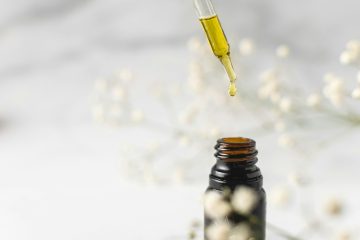CBD, an abbreviation of cannabidiol, and THC, short for tetrahydrocannabinol, are not the only compounds found in cannabis, but they are the two most talked about. Keep reading to find out everything you need to know about the differences between these two important compounds.
Both CBD and THC belong to a family of chemical compounds called cannabinoids, which are found inside cannabis plants. It is when we consume cannabinoids that dozens of fascinating interactions can take place. These interactions affect vital parts of our physiology, which is why CBD oils and other cannabinoid-based products are so popular.
To date, there are over a hundred known cannabinoids within the Cannabis sativa species—with some sources stating an exact figure of 113. CBD and THC are the ones produced in the greatest quantities, hence the focus on them. The others can still affect the body, but they are harder to isolate and we know less about their potential impact.
What is CBD?
Cannabidiol (CBD) is the second most abundant compound in Cannabis sativa, but that does not make it any less effective. CBD possesses a couple of unique abilities that THC cannot match. It is also the main ingredient in the popular wellness supplement CBD oil.
CBD is non-toxic, and non-intoxicating and is said to have the potential to affect well-being by promoting important biological processes.
What is THC?
THC is the main compound in Cannabis sativa. Besides the concentration, THC’s notoriety comes from its psychotropic side effects.
While CBD (and other cannabinoids) can affect well-being without noticeable side effects, THC interacts with specific regions of the brain and causes a euphoric feeling (high) that temporarily affects the way we think and feel.
Where do THC and CBD come from?
We have already hinted at their origin, but both CBD and THC come from Cannabis sativa species and form an essential part of its chemical structure.
Cannabis sativa is a versatile and extremely resistant species, divided into dozens of types, subspecies, and cultivars. Hemp and marijuana are the most common varieties, but there are thousands of others, all with slightly different properties. However, they have one thing in common―a chemical structure with CBD, THC, and hundreds of other cannabinoids, terpenes, and flavonoids.
There are other sources of these compounds (various plants, fruits, vegetables), but Cannabis sativa has by far the highest concentration of them all. And while we don’t yet fully know why, the human body has evolved to respond to all three of these ecological compound families.
What is the difference between hemp and marijuana?
The key difference between hemp and marijuana is their chemical structure. Although the plants may look the same to the naked eye, they look a lot different under a microscope.
Unlike cannabis, Hemp is naturally rich in CBD, and low in THC. As a result, hemp is legal in most parts of the modern world, assuming that the THC concentration is below 0.2-0.3%. The good news is that commercial cultivation has significantly reduced THC levels in hemp. As a result, it makes it a perfect candidate for CBD oils, capsules, and more.
On the other hand, marijuana is rich in THC but, depending on the variety, it can contain significant levels of CBD.
How CBD and THC affect the body
Knowing where CBD and THC come from is one thing, but understanding how they affect the human body is a completely different challenge. Fortunately, scientists continue to work hard to uncover exactly how cannabinoids work.
CBD
Most cannabinoids work by affecting special receptors found in the body. When receptors detect a cannabinoid, they interact and a biological reaction is activated depending on the type of receptor, its position and the cannabinoid in question. However, CBD likes to work in a slightly different way.
When you consume CBD, it works quietly to strengthen the entire receptor network. That’s not to say it can’t interact with these receptors one by one, but it prefers to take a general approach to wellness. Therefore, CBD is said to have the potential to affect:
- Mood
- Appetite
- Immune response
- Sleep
THC
THC works more directly by binding directly to receptors in the brain and digestive system. It is this interaction that causes the psychotropic side effects we mentioned earlier, such as:
- Increased appetite
- Slower reaction time
- Worse memory and coordination
- Altered mental mood
As you can see from the difference in potential effects, these two compounds act in very different ways―despite coming from the same species.
Chemical composition in CBD and THC
CBD and THC actually have exactly the same molecular structure:
- 21 carbon atoms
- 30 hydrogen atoms
- 2 oxygen atoms
CBD and THC are so-called isomers. This means that they have the same chemical formula, C21H30O2, but different structures and pharmacological properties. A small difference in the way the atoms are put together in the molecule means that CBD has a completely different effect on your body than THC.
What CBD and THC have in common is that they are chemically similar to your body’s own endocannabinoids. Therefore, they can interact with your cannabinoid receptors.
When CBD or THC reacts with the cannabinoid receptors, neurotransmitters are released in your brain. Signal substances take care of communication between different cells in the body. They are involved in the processes of how your body feels pain, manages the immune system, deals with stress, sleep and much more.
Psychoactive components
Despite the similarity, CBD and THC do not have the same psychoactive effects. Or rather: CBD is not a psychoactive compound. You cannot get “high” from taking CBD.
THC, on the other hand, binds to the cannabinoid-1 receptors in the brain (they are also called (CB1). When this happens, you experience a high or feeling of euphoria.
CBD binds very weakly, if at all, to the CB1 receptors. CBD can actually dampen the effect of THC.


